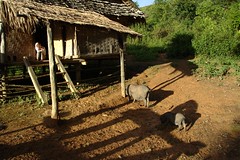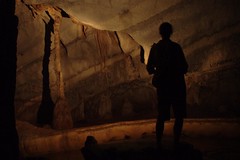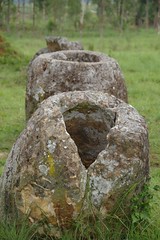On the border with China, Lao Cai is about as fun as all border towns can be - not very. Though there should be, there is no romance in these towns; they are just a place where day trippers from across the border come to spend their money on goods they can't get at home.
The place was hot. Extremely hot. And we made the mistake of arriving in town in the morning and then having a whole day to fill before departing on the overnight train to Hanoi. This was a disaster. We walked around and sweated buckets - literally buckets. I haven't experienced a place this hot since Cambodia.
To add to the heat and make us feel sick of the travel, we were scammed into overpaying for train tickets. In our desperation to get out of the place, we went to a travel agent and not the official train ticket office. (The train office was shut for lunch - for 4 hours.) The agent promised only first class was available - but for the A+ price we got the C- seats. Getting ripped off puts you in bad mood.
Then there were the couple of weeks of hard travel getting to Lao Cai. Coming across the mountains of Northern Laos was slow work. After making it to Vietnam there was Dien Bien Phu another boring border town. Then there were more mountain roads to negotiate - including another stint at pushing a bus through mud - to get to the touristy Sapa. And then whilst in Sapa all we seemed to get was hassled by the local hill tribe women throughout the town. After Laos, we had forgotten what the Vietnamese hard sell was like.
Hanoi was a haven. Another holiday from our holiday. but with more things to do than read books.
A lethargic pace descended on us during the five nights there. A couple of sightseeing activities during the day, and the rest of the time rambling about the brilliant Old Quarter - poking our noses into the little cafes, bars and restaurants - was how we spent our time. It was a great break.
A ritual developed while we were there. Although you have best intentions to check out all the good spots, you invariably find a few brilliant places initially and then the other spots don't quite compare later.
For breakfast it was a baguette and omelette combination for a miserly (or masterly) 40 cents from a little woman whipping up these fantastic delicious morsels from a gas burner on the footpath. A nearby tin oven warmed the bread while we munched through them sitting on plastic stools not a hand span high.
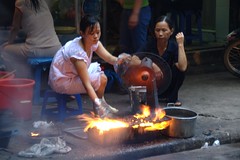
Street side dining
An iced coffee sweetened with condensed milk – a Hanoi institution it seemed - was followed after from another little plastic stool place around the corner. These street side cafes do one item, for a pittance, and do it well. We loved Hanoi.
There were of course the restaurants. We didn't even make a dent in the listings of high class, cheap eateries. Thankfully we are going back in a week for some more. Have I mentioned that Hanoi is cosmopolitan? I guess we can thank the French for that. So chic, so Frenchy.
In between eating our way around the city there were things to see. The Museum of Ethnology was high class and could have been found in any western city. The indoor very informative exhibits on the various races to be found in Vietnam were supremely complimented by short docos and, outside, full scale reconstructions of traditional houses which you could wander through.
We also paid our respects to Uncle Ho in his big ugly concrete bunker. Soldiers in full white dress uniform didn't let us linger as we, and a whole bunch of Vietnamese, filed past waxen old Ho Chi Minh lying stately in his glass case. I missed seeing Lenin and Mao when passing through Moscow and Beijing respectively, so it was about time I saw one of the triumvirate. (As a side thought I guess when old Fidel finally passes on there could have a forth Madame Tussuad's contract being worked on in Havana).
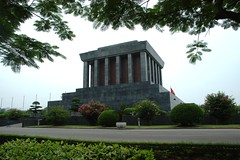
Uncle Ho in da bunker
So we now have moved on from Hanoi, but like I said we will be back – we do have a plane to catch from there in a little over a week. In the meantime there are a few sites to see in the vicinity, including a(nother) world heritage natural wonder. Till next time, with batteries recharged and the travel zest back...
